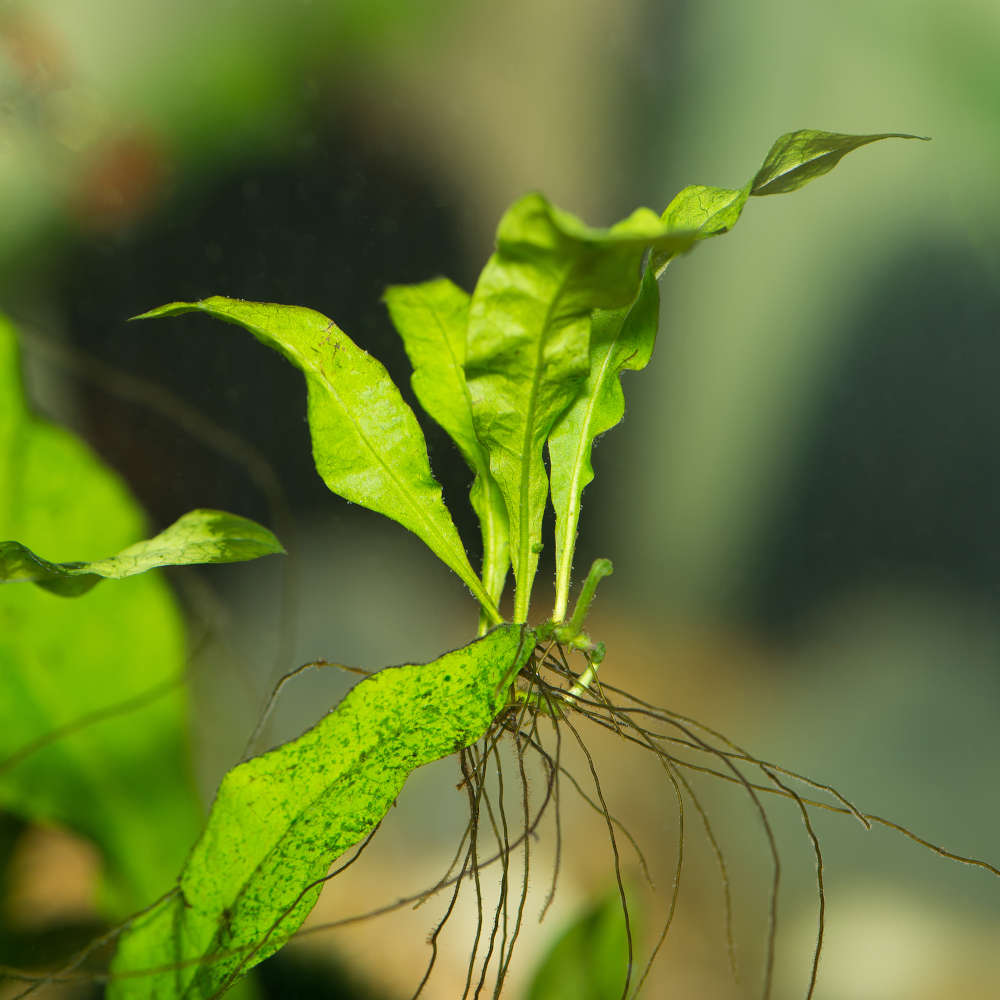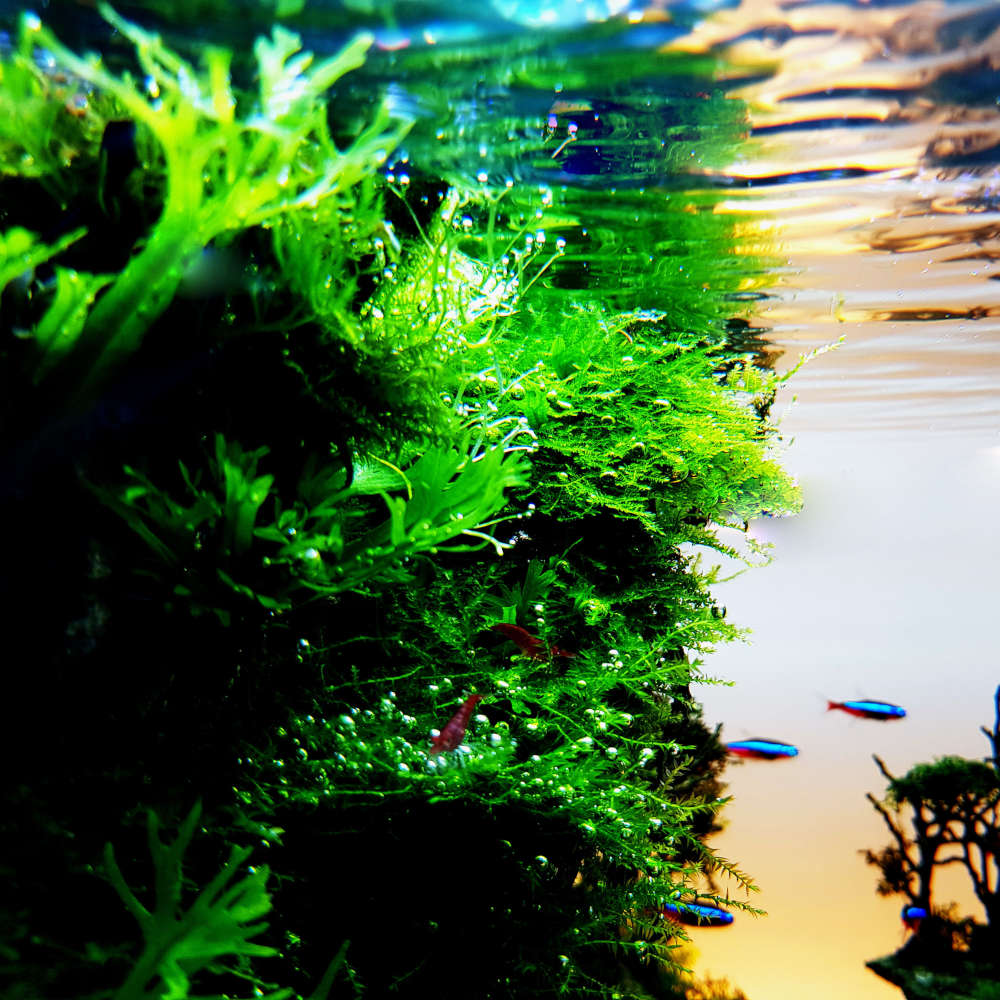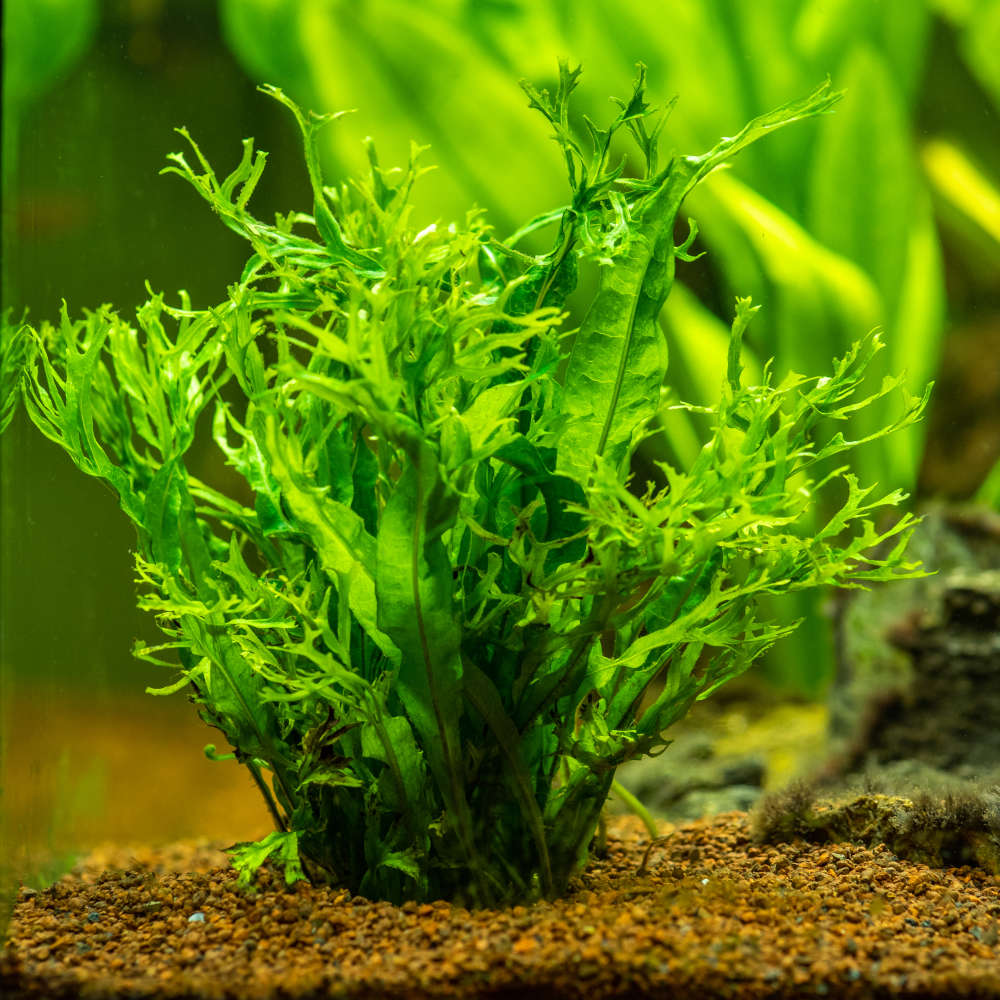This species is loved by both novice and seasoned aquarists. As an amphibious plant, it’s a great choice for water garden enthusiasts as well. It’s also low-maintenance, which makes it easy to care for.
So, if you’re all in to bring this plant home, let’s know all about it!
What is Java Fern?
Java Fern is an adaptable and sleek-looking plant for your freshwater tank that is the favorite for aquarium lovers and keepers.
| Origin | Widespread in Southeast Asia |
| Scientific Name | Leptochilus pteropus |
| Common Names | Java fern |
| Appearance | Long leathery green leaves, brown rhizome, fuzzy dark brown roots |
| Size | Up to 33 cm (13 in) |
| Growth Rate | Slow (2.5 cm or 1 inch/month) |
| Care Level | Easy |
| Minimum Tank Size | 10 gallons |
| Water Temperature | 68-82 °F (20-28 °C) |
| pH Level | 6-7.5 |
| Water Hardness | 3-10 dGH |
| Lighting | Dim light |
| CO2 | Not required |
| Propagation | Natural plantlet forming, cutting rhizome with leaves |
What is the Natural Habitat of Java Fern?
Java fern, named after the Java Islands of Indonesia, originates from a number of Southeast Asian nations like:
- Malaysia
- Thailand
- Northeast India
- China
- Cambodia
- Bangladesh
- Hong Kong
- Japan
- Indonesia
- Nepal
- Philippines
In the wild, the aquatic and semi-aquatic plant grows attached to rocks, tree trunks, and roots. You’ll spot it along the freshwater fast-flowing river and stream banks, lowland marshes, and sometimes even brackish environments.
According to the 2011 assessment of The IUCN Red List, it’s labeled Least Concern.
Which Family do Java Fern belong?
The plant belongs to the Polypodiaceae family under the Polypodiales order. Commonly known as Java fern, its binomial name is Leptochilus pteropus.
Interesting Fact: The plant is a column feeder, i.e., it directly absorbs nutrition from the water column via photosynthesis.
How do Java Fern Look?

Java fern has three parts:
- Long, leathery, bright green pointy leaves. There are several variants depending on leaf type:
- “Narrow leaf” has long and narrow leaves and grows up to 25-30 cm (10-12 in).
- “Needle leaf” has even thinner leaves and grows up to 15 cm (6 in).
- “Windelov” has a bladed leaf bottom and lacy or shredded leaf top and grows up to 10-17 cm (4-7 in).
- “Trident” has narrow leaves forking off from each other, which seems like a trident, and grows up to 15-20 cm (6-8 in).
- Thin brown root-like rhizome, which is actually a stem. It’s the part between the leaves and roots. The plant absorbs water and nutrients through this.
- Dark brown and fuzzy roots anchor the plant to other objects – not the substrate, as it’s an epiphyte. The roots prevent it from getting flown away.
All variants have similar care needs.
What is the Size pf Java Fern?
On average, Java fern is sold at a young size of 8-13 cm (3-5 in). The adult plant has a maximum height of 15-33 cm (6-13 in).
What is the Growth Rate of Java Fern?
The growth rate of the plant is an inch/month. It takes almost a year to reach maturity. It grows a new leaf weekly, which grows thicker with time.
To accelerate the growth process, inject CO2 fertilizer or increase light intensity to more than 2 watts/gallon.
What are the Benefits and Uses of Java Fern?
There are various benefits to using Java fern in your freshwater aquarium, as follows:
Durability
The plant is pretty hardy and tolerates a range of pH levels, temperatures, and hardness. So, it’s ideal for beginners.
Low Light Needs
Many aquatic species need subdued lighting, and this plant can also thrive in it. Thus, it’s perfect for a variety of aquariums. Further, it also reduces algae growth chances.
Shelter
The long leaves provide great hiding spots for small, timid fish and invertebrates. It also creates a jungle-like environment for them to swim and play through.
Water Quality
The fern absorbs CO2 to thrive and replaces it with oxygen for the aquatic species. It breaks down nitrates in fish waste and absorbs them as nutrition. Overall, it maintains healthy water chemistry.
How to take care of Java Fern?

If you plan to add some Java fern to your aquarium, let’s first know its needs in terms of space, water chemistry, compatibility, and more!
What are the Tank Requirements for Java Fern?
What is the Tank Size required for Java Fern?
Java fern requires at least a 10-gallon tank due to the long leaves of the plants. Owing to its slow growth rate, many novice aquarists mistakenly add it to 5-gallon tanks.
If you wish to buy several ferns together, a 20-gallon tank is the ideal choice.
What is the Water Chemistry required for Java Fern?
While Java fern can tolerate a wide range of water parameters, maintain ideal parameters to encourage the best growth.
- pH Levels: 6-7.5
- Water Temperature:
- Ideal: 68-82 °F (20-28 °C)
- Tolerable: As low as 60 °F (15 °C)
- Water Hardness: 3-10 dGH
- Carbonate Hardness: 2-15 dKH
Which type of Soil is needed for Java Fern?
Java fern is not rooted to the substrate. Instead, it needs rocks and heavy pieces of wood to attach itself.
You can use a substrate of any choice, but don’t bury the plant into the substrate. Otherwise, the plant rhizome will rot. Alternatively, you can even keep the tank bare-bottomed.
What type of Lighting is required for Java Fern?
This plant thrives in dim lighting and may get burn spots and stunted growth from strong lights. So, use subdued fluorescent bulbs (color temperature: 5000-7500 Kelvin) and LEDs. On average, use 1.5-3 watts of light per gallon. Never expose it to direct sunlight.
What is the Water Flow Rate for Java Fern?
In the wild, the fern can withstand a wide range of flow. However, to help your plant’s good health, maintain a low to moderate current in the tank.
Does Java Fern need CO2?
CO2 injections make the plant grow quicker, but it is not necessary. Just ensure the filter and powerhead work efficiently.
What Fertilizers & Nutrition are required for Java Fern?
The fern gets enough nutrients from fish waste, so fertilizers aren’t necessary. However, if you have lots of plants, use liquid fertilizer sparingly during water changes to promote new growth and keep the plant healthy.
What are the Compatible Aquatic Species for Java Fern?
Java fern can’t be uprooted easily and has strong rhizomes; it’s compatible with most freshwater species like the following:
- Most tetras
- Most rasboras
- Betta
- Yoyo loach
- Kuhli loach
- Guppy
- Swordtail
- Goldfish
- Mountain minnow
- Rainbowfish
- Cory catfish
- Pictus catfish
- Celestial pearl danio
- Sparkling gourami
- Plecostomus
- South American Cichlid
- Vampire shrimp
- Nerite snail
- Mystery snail
- Newt
- Skink
- Frog
Which Species to Avoid for Java Fern?
Java fern is not suitable with large, aggressive and predatory fish like African cichlids. Especially the young plants can’t stand the damage from them.
What are the issues with Java Fern in Aquarium?
While the Java fern is pretty hardy, it comes with its own sets of issues like the following:
1. Algae
If the lights are on for too long, algal growth can be a great issue.
Solution:
- Keep the lights on for fewer hours.
- Reduce light intensity.
- Stop or reduce fertilizer usage.
- Perform greater and more frequent water changes.
- Introduce algae-eaters like Amano shrimp and nerite snails.
- Introduce another fast-growing plant (Vallisneria, watersprite, or others) to absorb excess nutrients.
- Don’t overfeed fish.
2. Discoloration
The leaves turn transparent and even change their shape. It indicates there’s excess or intense light in the tank.
Solution:
Reduce light intensity or duration of exposure to help the plant recover.
3. Browning
If you plant the fern into the substrate, the entire plant may turn brown. It signifies a serious sickness and even leads to death.
Solution:
Don’t keep the fern planted in the substrate.
4. Pests
Store-bought plants may come with snail eggs and other pests.
Solution:
To sterilize the plant:
- Soak it in a solution of 20 parts water – 1 part bleach solution for less than 2 minutes.
- Rinse with dechlorinated water.
5. Slow growth
Some aquarists report that their plant doesn’t grow for months.
Solution:
- Ensure ideal water chemistry (and 10-20 ppm potassium), planting technique, and lighting is suitable.
- Add fertilizers and CO2.
6. Overgrowth
In rare cases, the plant overgrows to the point it goes out of the tank.
Solution:
- Trim the plant more regularly.
- Stop fertilizing and CO2 addition.
- Sell it if it goes out of hand.
7. Melt
When first added to the tank, the plant adjusts to the new environment. The leaves turn brown or yellow-mush and die.
Solution:
- Don’t panic, as it’s normal.
- Trim the brown leaves.
- Add liquid fertilizer to encourage new growth.
8. Nitrogen Deficiency
It’s indicated by the yellowing of leaf tips to the base. The leaves then turn transparent. It may happen due to poorly cycled tank or blue-green algae growth.
Solution:
- Cycle the tank properly to avoid it.
- Get rid of BGA growth.
9. Brown Spots Under Leaves
Dark brown root-like structures grow on the underside of leaves. It’s not a disease and is a sign of plantlet/baby plant growth from the parent plant.
Solution:
You get new plants this way, so there’s nothing to worry about!
Planting, Growing, Propagating, & Pruning Java Fern in the Aquarium
Once you bring the Java fern home, you must place it strategically in the tank. This will ensure good health and growth of your plant and other tank mates.
How to Plant Java Fern in an aquarium?
The first step is to introduce the fern safely in secure it aesthetically. So, let’s get started!
1. Safe Introduction
Before introducing the plant in the tank, follow these steps:
- Remove all dead or decaying leaves.
- Perform bleach sterilization:
- While wearing gloves, mix 20 parts water and 1 part bleach in a bucket.
- Immerse the plant into this mixture and soak it for 2.5 minutes.
- Or perform alum sterilization:
- In a gallon of water at room temperature, dissolve 1-3 tablespoons of alum.
- Soak the plant in it for 3 hours.
- Take the plant out and rinse thoroughly with dechlorinated water.
- Keep the plant in a quarantine tank for 3-4 weeks and then introduce it to the main tank.
2. Tank Placement
It’s best to plant the fern in the mid and background. Otherwise, your aquarium view may get blocked.
3. Aquascaping
Java fern is epiphytic, so it doesn’t need to be rooted to the substrate. Attach the plant to different hardscapes like driftwood, rocks, shells, or other decor using
- Super glue – don’t use the method if it’s a young plant with delicate stems and leaves
- Fishing lines
- Thin black/brown cotton threads
- Rubber bands
Within a few weeks, its roots grow around the specific object and are secured. You can then cut any thread/line/band.
Tip: Some suggest dropping the plant into the aquarium and letting it float. However, the plant thrives better when anchored and not floating.
How to Propagate Java Fern in an Aquarium?
To propagate the plant, follow either of these methods:
- Cut a section of the rhizome with leaves. Glue or tie it to an object. It’ll eventually grow into a full-fledged plant.
- Let the plant mature and naturally grow brown spots under its leaves. They’ll sprout with time into tiny plants. Cut off the tiny plants and place them in appropriate positions.
Tip: Add potassium/manganese/iron-rich liquid fertilizer to prevent the parent plant from rotting.
How to Prune Java Fern from the Aquarium?
The slow-growing plant doesn’t need regular pruning. Rather, the adult plant needs one yearly pruning. However, if it overgrows, follow these steps to reduce the leaf density:
- Lower the water level in the tank so you can reach the plant
- Cut dead leaves with sharp prunes/scissors.
- To diminish the bushy appearance, cut old leaves pretty close to the rhizome.
Tip: Use sharp scissors. Blunt ones tear more, cause damage to the plants, and also infect them with diseases.
How to Buy Java Fern?
When you buy Java fern, look for these signs of good health:
- Leathery leaves
- Hard roots
- Well-developed rhizome
- Overall firm plant
- No tears or missing chunks in leaves
- Only green leaves
Avoid plants with these signs:
- New plantlets in young plant – it’s a sign of a stressed plant, and the parent plant may not survive
- Brown, yellow, or discolored leaves
At the time of writing this article, the plant is sold in online stores for around $7-10 for bare-root ones and $15-20 for potted ones. Depending on your location, you may get it for lower prices.
A word from FishInAquarium
Java fern is one of the most widely used plants in the aquarium industry. It’s not only light on the pocket but also grows and propagates effortlessly. So, you can have several more ferns from one in no time.
If you enjoyed this article, share it with your other planted tank enthusiasts. Let them show love to this green beauty. If you have more questions, send us an email, and our team will answer you right away!


